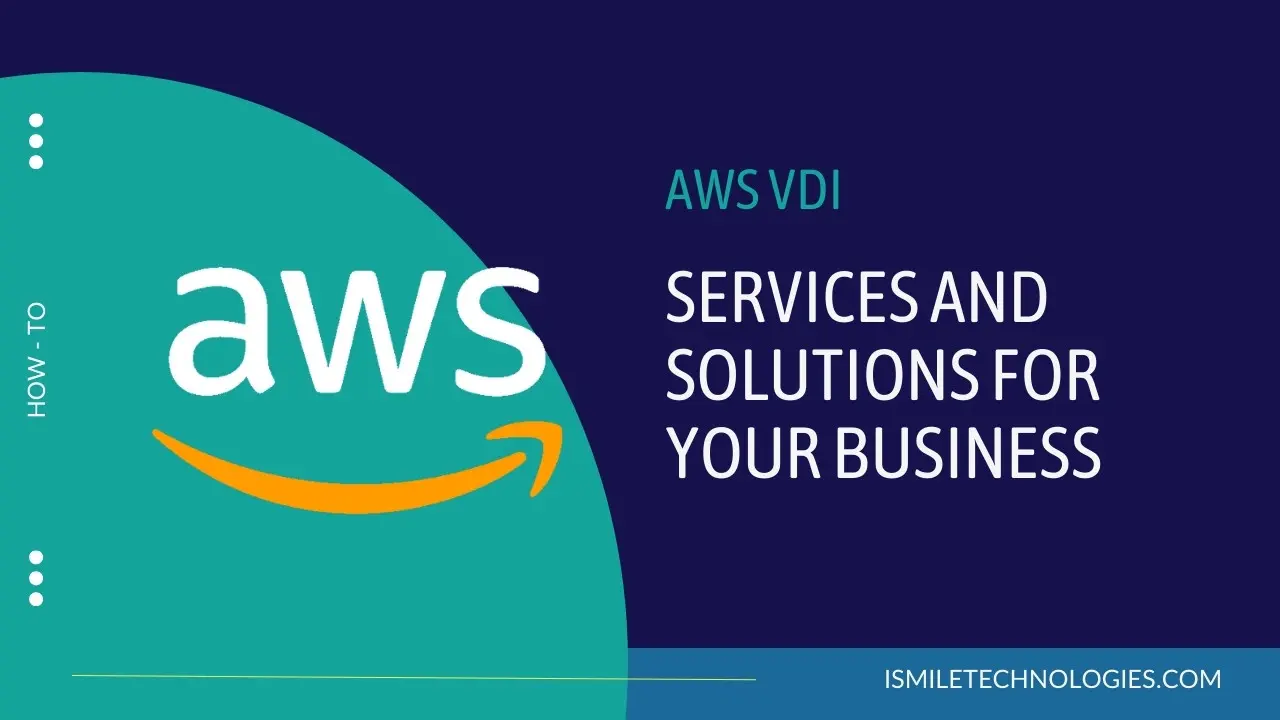In today’s digital age, businesses are increasingly adopting cloud-based solutions to enhance their productivity, efficiency, and security. One such solution is Virtual Desktop Infrastructure (VDI), which allows organizations to provide virtual desktop environments to their employees, enabling them to access their workspaces from anywhere, on any device. AWS (Amazon Web Services) offers a range of VDI services and solutions that cater to the diverse needs of businesses. In this article, we will explore the benefits, solutions, implementation, best practices, use cases, challenges, and comparisons of AWS VDI services.
Understanding Virtual Desktop Infrastructure (VDI)
VDI is a technology that enables the creation and management of virtual desktops hosted on remote servers and delivered to end-users over the network. It allows employees to access their desktops, applications, and data securely from any location, eliminating the limitations of traditional physical desktop environments. By centralizing desktop management, VDI offers enhanced security, simplified administration, and improved flexibility.
Benefits of AWS VDI Services
AWS VDI services bring numerous advantages to businesses of all sizes. Let’s explore some of the key benefits:
Flexibility and Scalability:
AWS VDI services provide businesses with the flexibility to scale their virtual desktop infrastructure according to their changing needs. Whether you need to add or remove users, increase computing resources, or expand to new geographical locations, AWS offers the scalability to accommodate your requirements.
Cost-Effectiveness:
With AWS VDI services, businesses can significantly reduce their upfront infrastructure costs. By eliminating the need for on-premises hardware, businesses can leverage AWS’s pay-as-you-go pricing model, paying only for the resources they consume. This cost-effective approach allows organizations to optimize their IT budgets and invest in other strategic initiatives.
Enhanced Security:
AWS prioritizes security and compliance, providing robust measures to protect your virtual desktop environment. AWS VDI services offer features such as multi-factor authentication, encryption, network isolation, and data loss prevention. With AWS’s security expertise and compliance certifications, businesses can ensure the confidentiality and integrity of their sensitive data.
Improved Performance and Productivity:
By leveraging AWS’s global infrastructure, businesses can provide their employees with high-performance virtual desktops. AWS VDI services ensure low latency, enabling seamless access to applications and data, regardless of the user’s location. This improved performance translates into increased productivity and user satisfaction.
AWS VDI Solutions
AWS offers a comprehensive suite of VDI solutions that cater to different use cases and requirements. Let’s explore some of the key solutions:
Amazon WorkSpaces:
Amazon WorkSpaces is a fully managed desktop-as-a-service solution that allows businesses to provision virtual desktops quickly. With WorkSpaces, organizations can choose from different bundles, offering varying compute power, memory, and storage capacities. WorkSpaces provides a secure and persistent desktop experience, ensuring that users’ data and preferences are preserved across sessions.
Amazon AppStream 2.0:
Amazon AppStream 2.0 enables businesses to stream desktop applications to users’ devices securely. AppStream 2.0 eliminates the need for application installations on users’ devices, simplifying management and reducing compatibility issues. This solution is particularly useful for resource-intensive applications that require high performance and collaboration.
Amazon WorkLink:
Amazon WorkLink simplifies secure access to internal web applications for mobile users. It eliminates the need for complex VPN setups and enables users to access internal applications through a secure browser on their mobile devices. WorkLink ensures data privacy and compliance while providing a seamless user experience.
Amazon WorkDocs:
Amazon WorkDocs is a fully managed, secure content collaboration service that allows teams to create, edit, share, and collaborate on documents in real-time. WorkDocs integrates seamlessly with other AWS services, providing a unified platform for document management and collaboration.
Setting Up AWS VDI Services
Setting up AWS VDI services involves a series of steps to configure and manage the different solutions. Let’s explore the setup process for each solution:
Creating and Managing WorkSpaces:
To set up WorkSpaces, you need to choose the desired bundle, select the operating system, and configure user access. WorkSpaces can be managed using the AWS Management Console or programmatically using the AWS CLI or SDKs. Administrators can assign users to specific WorkSpaces, manage security policies, and customize the user experience.
Configuring AppStream 2.0 Applications:
Configuring AppStream 2.0 involves packaging and uploading the applications to the AppStream 2.0 service. Administrators can define access policies, set up user entitlements, and monitor application usage through the AppStream 2.0 console. Users can access the applications securely via web browsers or client applications.
Implementing WorkLink for Secure Access:
Implementing WorkLink requires configuring the WorkLink client and associating it with the desired domain. Administrators can define access policies and whitelist internal web applications that users can access via WorkLink. WorkLink integrates with existing identity providers, simplifying user authentication and authorization.
Collaborating with WorkDocs:
Collaborating with WorkDocs involves creating folders, inviting team members, and granting appropriate access permissions. Users can create, upload, and edit documents in real-time, and changes are automatically synced across devices. WorkDocs provides version control, file commenting, and notification features to enhance collaboration.
Best Practices for AWS VDI Implementation
To ensure a successful AWS VDI implementation, consider the following best practices:
Right-Sizing WorkSpaces:
Analyze the resource requirements of your users and choose the appropriate WorkSpaces bundle to avoid overprovisioning or underprovisioning. Right-sizing ensures optimal performance and cost efficiency.
Leveraging User Profiles and Policies:
Utilize user profiles and policies to manage user settings, permissions, and access controls efficiently. By defining user profiles, you can provide a consistent experience and enforce security policies across your VDI environment.
Integrating with Active Directory:
Integrate AWS VDI services with your existing Active Directory infrastructure to simplify user management and authentication. Active Directory integration allows users to log in using their existing credentials and ensures consistent user identity across systems.
Monitoring and Managing VDI Environment:
Implement monitoring tools and processes to track VDI performance, resource utilization, and user activity. Monitoring enables proactive troubleshooting, capacity planning, and security incident detection.
Use Cases for AWS VDI Services
AWS VDI services cater to various use cases across different industries. Let’s explore some common scenarios where businesses can benefit from AWS VDI:
Remote and Mobile Workforce:
AWS VDI services enable organizations to support remote and mobile employees, providing them with secure access to their workspaces from anywhere. This flexibility allows employees to work from home, while traveling, or in temporary office setups.
Software Development and Testing:
VDI solutions are valuable for software development and testing teams. Developers can quickly spin up virtual environments, test software on different operating systems, and collaborate seamlessly. VDI simplifies the management of development environments and improves overall productivity.
Customer Support and Call Centers:
AWS VDI services are ideal for customer support and call centers. Agents can access their virtual desktops with all the necessary applications and customer information, improving efficiency and customer service quality. VDI also enables flexible staffing options for call centers, accommodating peak demands.
Educational Institutions:
VDI solutions have gained popularity in educational institutions, enabling virtual classrooms and remote learning. With AWS VDI services, students and teachers can access educational resources, collaborate on projects, and participate in virtual labs from any location.
Challenges and Considerations
While AWS VDI services offer numerous benefits, there are certain challenges and considerations to keep in mind:
Bandwidth and Network Requirements:
VDI requires a reliable and high-bandwidth network connection to ensure a smooth user experience. Organizations need to assess their network infrastructure and consider the network demands of their VDI deployment.
Data Governance and Compliance:
Organizations must adhere to data governance and compliance requirements when implementing VDI. It’s crucial to protect sensitive data, ensure data residency compliance, and implement appropriate access controls and encryption mechanisms.
User Experience and Support:
Providing a seamless user experience is vital for VDI adoption. Organizations should invest in user training, provide clear documentation, and offer technical support to address user queries and issues promptly.
Training and Adoption:
VDI adoption often requires users to adjust to a new way of working. Organizations should provide training and change management initiatives to ensure a smooth transition and maximize user adoption.
Comparison with Other VDI Solutions
While AWS VDI services provide comprehensive solutions, it’s essential to compare them with other VDI offerings in the market. Let’s explore some notable comparisons:
Microsoft Azure Virtual Desktop:
Microsoft Azure Virtual Desktop offers similar capabilities to AWS VDI services. Both solutions provide scalable virtual desktop infrastructure, integration with existing IT environments, and strong security features. The choice between AWS and Azure depends on specific business requirements and existing cloud ecosystems.
Citrix Virtual Apps and Desktops:
Citrix Virtual Apps and Desktops offer advanced VDI capabilities and extensive management features. Citrix focuses on delivering a high-definition user experience, enhanced application compatibility, and flexible deployment options. Organizations that require advanced customization and management may prefer Citrix solutions.
VMware Horizon:
VMware Horizon is another prominent VDI solution that offers a wide range of features and integrations. VMware’s extensive experience in virtualization and desktop management makes Horizon a preferred choice for organizations already invested in VMware technologies.
Need help on maintaining Azure Security Center Secure Score of Clients?
Our experts can help you on all kinds of works on Azure Security Center.
Conclusion
AWS VDI services provide businesses with flexible, scalable, and secure virtual desktop infrastructure solutions. By leveraging AWS’s offerings such as Amazon WorkSpaces, AppStream 2.0, WorkLink, and WorkDocs, organizations can empower their workforce, enhance productivity, and improve overall efficiency. However, successful implementation requires careful planning, consideration of best practices, and addressing potential challenges. By evaluating use cases, comparing solutions, and adopting the right strategies, businesses can harness the full potential of AWS VDI services.








